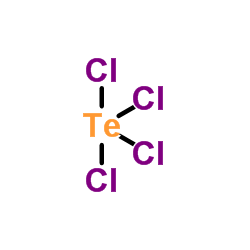Tellurium tetrachloride and diphenyl ditelluride cause cytotoxicity in rat hippocampal astrocytes.
Shalini Roy, Diane Hardej
文献索引:Food Chem. Toxicol. 49(10) , 2564-74, (2011)
全文:HTML全文
摘要
Tellurium tetrachloride (TeCl(4)) and diphenyl ditelluride (DPDT) cytotoxicity, was investigated in rat astrocytes. Concentrations of 0.24-250μM (24h) were tested for viability using MTT(3-[4,5-dimethylthiazol-2-yl]-2,5-diphenyl tetrazolium bromide) and trypan blue exclusion. MTT showed significant decreases at all concentrations tested for both compounds. Significant decreases in viability were seen in 1.95-250μM of DPDT and 0.97-250μM of TeCl(4) with trypan blue exclusion. The LC(50) for both compounds was 62.5μM. Light and scanning microscopy confirm toxicity observed at higher concentrations. Thiobarbituric acid reactive substances (TBARs) assay, TUNEL, cytochrome c and caspase release were carried out. No significant increase in TBARS with either agent was observed (15.625-62.5μM). TUNEL and cytochrome c assays demonstrated apoptosis in TeCl(4) treated cells (31.25-125μM). Non-apoptotic cells were observed in DPDT treated cells. Studies of caspase 3/7 and caspase 9 indicated increased activity in TeCl(4) but not in DPDT treated cells. Optical Emission Spectroscopy of DPDT and TeCl(4) treated cells demonstrated significant accumulation of elemental tellurium in all treatment groups (31.25-125μM). We conclude that DPDT and TeCl(4) are cytotoxic to astrocytes. TeCl(4) treated cells die via the intrinsic apoptotic pathway. Accumulation of tellurium occurs with both compounds, but results in different mechanisms of cell death.Copyright © 2011 Elsevier Ltd. All rights reserved.
相关化合物
| 结构式 | 名称/CAS号 | 分子式 | 全部文献 |
|---|---|---|---|
 |
四氯化碲
CAS:10026-07-0 |
Cl4Te |
|
Myocardial ultrastructural alterations in ducklings fed tell...
1982-11-01 [Am. J. Vet. Res. 43(11) , 2000-9, (1982)] |
|
Cytometric analysis of adverse action of diphenyl ditellurid...
2004-12-01 [Environ. Toxicol. 19(6) , 614-9, (2004)] |
|
Synthesis of novel E-2-chlorovinyltellurium compounds based ...
2012-01-01 [Molecules 17(5) , 5770-9, (2012)] |
|
Selective inhibition of Zn(2+)-glycerophosphocholine choline...
1992-06-15 [Biochem. J. 284 ( Pt 3) , 641-3, (1992)] |
|
Evaluation of tellurium toxicity in transformed and non-tran...
2012-11-01 [Environ. Toxicol. Pharmacol. 34(3) , 768-82, (2012)] |